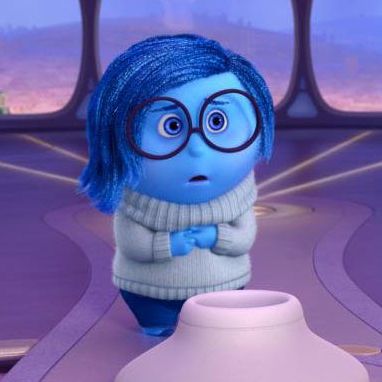
Amy Poehler and I sat there, stumped. In the middle of an interview about Inside Out, IÔÇÖd mentioned that as far as I could remember, there had never before been an animated buddy movie starring two female characters. Both of us racked our brains. Could that really be true?
ÔÇ£I guess thereÔÇÖs Frozen, right?ÔÇØ she ventured.
ÔÇ£Yeah, but the sisters arenÔÇÖt buddied up,ÔÇØ I pointed out. ÔÇ£AnnaÔÇÖs on an adventure with Kristoff for most of the movie, and ElsaÔÇÖs on her own.ÔÇØ
ÔÇ£Right, theyÔÇÖre two separate characters,ÔÇØ said Poehler. ÔÇ£The Hope/Crosby of the film.ÔÇØ
We thought about it some more. Brave, maybe? I said. Except there, Merida is buddied up with a transformed bear 
  who doesnt talk.
We smiled ruefully.
Countless cartoons have been built around male duos ÔÇö Woody and Buzz Lightyear from the first Toy Story come to mind, as do Aladdin and Genie, Mike and Sulley from Monsters, Inc., and Carl and Russell from Up ÔÇö but the formula that comes so naturally to animated movies has rarely, if ever, received a distaff spin. ThatÔÇÖs one of the many reasons why Inside Out, the new Pixar movie starring Poehler, is so novel. The movie is set inside the mind of 11-year-old Riley, where Joy (Poehler) presides over a group of influential emotions, including Fear (Bill Hader), Disgust (Mindy Kaling), and Anger (Lewis Black). But of the lot,┬áJoy most frequently finds herself at odds with the morose Sadness (Phyllis Smith). When the two of them are accidentally ejected from their control center and cast off into the farthest reaches of RileyÔÇÖs mind, Joy and Sadness must overcome their differences and rely on each other to make their way back. Without much fanfare, the movie at that point becomes a Bechdel-compliant buddy comedy.
It wasnÔÇÖt originally conceived that way. Director Pete Docter has said that he first drafted Inside Out to pair Joy with Fear before realizing that Sadness would provide more organic comic conflict. It was a change that feels fresh on the movie screen, and even if the duo sometimes becomes a trio as they travel through RileyÔÇÖs mind with her long-forgotten imaginary friend Bing Bong (voiced by Richard Kind), the two female emotions spend large swaths of the movie paired only with each other, their opposed viewpoints clashing in a way thatÔÇÖs both pleasingly familiar and brand-new.
This sort of team-up shouldnÔÇÖt be too much to expect from animated movies. Yet all too often, the people who make and market these cartoons seem fearful to push their female characters to the forefront. This yearÔÇÖs CG-animated Home was a buddy movie that paired a little girl with a male alien; IÔÇÖll let you guess which one of those characters DreamWorks hid from most posters. The charming teaser-trailer for DisneyÔÇÖs upcoming Zootopia is narrated by Jason Bateman, who plays a fox, while the movieÔÇÖs actual protagonist, a female bunny rabbit played by Ginnifer Goodwin, gets nary a line. And after Disney execs changed the name of their CG-animated feature Rapunzel to the gender-neutral Tangled in the hopes that it would attract more boys, they pulled the same move with their long-in-development project The Snow Queen, retitling it Frozen and launching a campaign that buried its two female leads in so much snow that you could barely discern their gender (and then outnumbered them by adding three male supporting characters to the poster).
Boys came to Frozen, just as Disney had intended, but it was the repeat attendance of girls that made that Oscar-winning blockbuster the highest-grossing animated movie of all time. Even though Anna and Elsa are kept apart for most of the movie, itÔÇÖs their bond that matters most in the end. Pixar head John Lasseter said last month in Cannes that heÔÇÖs trying to make his animated movies more diverse, but even in something as progressive as Inside Out, thereÔÇÖs still room to grow. I couldnÔÇÖt help but notice that when we leap into the mind of RileyÔÇÖs mom, all five of her guiding emotions are female, and inside the mind of RileyÔÇÖs dad, his five emotions are male. (Later, brief trips into more supporting charactersÔÇÖ minds hew to those same gender guidelines.) Riley is the only character who has both male and female emotions steering her mind ÔÇö and while some might be quick to celebrate that as an example of her nascent gender fluidity, I couldnÔÇÖt help but come to a more cynical conclusion: Pixar felt that a movie starring five female emotions would be a bridge too far for the young boys who would come see Inside Out and want to buy toys from it.
ThereÔÇÖs a long-held maxim in Hollywood that men wonÔÇÖt go to movies starring women, but women will still see films aimed at men. When you notice how gingerly the makers of animated movies treat that same gender issue, you realize that this pernicious way of thinking starts all too early. Inside Out asks us to look inside a young girlÔÇÖs mind and realize that the lessons she learns at a formative age can carry much weight. LetÔÇÖs hope that movie marketers and studio decision-makers are learning something, too.

